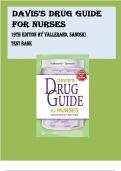Exam (elaborations)
TEST BANK FOR DAVIS'S DRUG GUIDE FOR NURSES 19TH EDITION BY VALLERAND, SANOSKI Latest Verified Review 2024 Practice Questions and Answers for Exam Preparation, 100% Correct with Explanations, Highly Recommended, Download to Score A+
TEST BANK FOR DAVIS'S DRUG GUIDE FOR NURSES 19TH EDITION BY VALLERAND, SANOSKI Latest Verified Review 2024 Practice Questions and Answers for Exam Preparation, 100% Correct with Explanations, Highly Recommended, Download to Score A+ Table Of Contents HOW TO USE DAVIS’S DRUG GUIDE FOR NURSES E...
[Show more]



